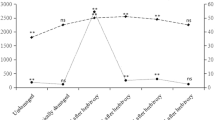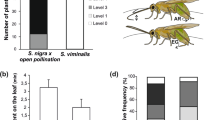Abstract
Sensory organs that detect CO2 are common in herbivorous moths and butterflies, but their function has been unclear until now. As the CO2 gradients in the vicinity of a host plant depend on its physiological condition, CO2 could provide a sensory cue for the suitability of the plant as a larval food source. This study investigated whether changing the atmospheric CO2 concentration affected oviposition by Cactoblastis cactorum on its host, the cactus Opuntia stricta. On host plants exposed to rapid fluctuations in CO2 concentration, the frequency of oviposition was reduced by a factor of 3.2 compared to the control. As the fluctuations mask the much smaller CO2 signals generated by the plants, this suggests that those signals constitute an important component of the host identification process. On host plants exposed to a constant background of doubled CO2, oviposition was also reduced, by a factor of 1.8. An increased background reduces host signal detectability, partially as a consequence of a general principle of sensory physiology (Weber-Fechner's law), and partially due to other factors specific to CO2-receptor neurons.
Similar content being viewed by others
Author information
Authors and Affiliations
Additional information
Received: 4 October 1996 / Accepted: 16 January 1997
Rights and permissions
About this article
Cite this article
Stange, G. Effects of changes in atmospheric carbon dioxide on the location of hosts by the moth, Cactoblastis cactorum . Oecologia 110, 539–545 (1997). https://doi.org/10.1007/s004420050192
Issue Date:
DOI: https://doi.org/10.1007/s004420050192




